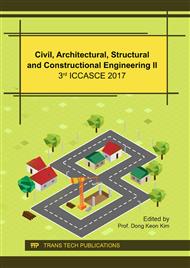[1]
A. Mistriotis, G. P. A. Bot, P. Picuno, et a1. Analysis of the efficiency of greenhouse ventilation using computational fluid dynamics. Agric. Forest Meteorol. 85 (1997) 217-228.
DOI: 10.1016/s0168-1923(96)02400-8
Google Scholar
[2]
T. Boulard, R. Haxaire, M. A. Lamrani, et a1. Characterization and modeling of the fluxes induced by natural ventilation in a greenhouse. J. Agric. Eng. Res. 74 (1999) 135-144.
DOI: 10.1006/jaer.1999.0442
Google Scholar
[3]
L. Yang, Green building design: Wind environment of building, Shanghai: Tongji University Press, (2014).
Google Scholar
[4]
I. B. Lee, T. H. Short, Two-dimensional numerical simulation of natural ventilation in a multi-span greenhouse. Trans. ASAE, 43(3) (2000) 745-753.
DOI: 10.13031/2013.2758
Google Scholar
[5]
J. Niemelä, Ecology of urban green space: the way forward in answering major research questions. Landsc. Urb. Plan. 125 (2014) 298-303.
DOI: 10.1016/j.landurbplan.2013.07.014
Google Scholar
[6]
D. M. Francisco, L. V. Diege, J. A. Antonio, Measurement and simulation of climate inside Almeria-type greenhouses Using computational fluid dynamics. Agric. Forest Meteorol. 125 (2004) 33-51.
DOI: 10.1016/j.agrformet.2004.03.009
Google Scholar
[7]
T. Kim, S. Kato, S. Murakami, Indoor cooling/heating load analysis based on coupled simulation of convection, radiation and HVAC control. Build. Envir. 36(7) (2001) 901-908.
DOI: 10.1016/s0360-1323(01)00016-6
Google Scholar
[8]
L. Yang, B. J. He, M. Ye, The application of solar technologies in building energy efficiency: BISE design in solar-powered residential buildings. Tech. Soc. 38 (2014) 111-118.
DOI: 10.1016/j.techsoc.2014.03.002
Google Scholar
[9]
T. Kim, S. Kato, S. Murakami, Indoor climate design based on CFD coupled simulation of convection, radiation, and HVAC control for attaining a given PMV value. Build. Envir. 36(6) (2001) 701-709.
DOI: 10.1016/s0360-1323(00)00069-x
Google Scholar
[10]
L. Yang, Green building design: Building energy efficiency, Shanghai: Tongji University Press, (2016).
Google Scholar
[11]
J. C. Lam, A. L. S. Chan, CFD analysis and energy simulation of a gymnasium. Build. Envir. 36(3) (2001) 351-358.
Google Scholar
[12]
L. Yang, B. J. He, M. Ye, CFD Simulation Research on Residential Indoor Air Quality, Sci. Total Envir. 472 (2014) 1137–1144.
DOI: 10.1016/j.scitotenv.2013.11.118
Google Scholar
[13]
D. B. SPaliding, S. Zhubrrin, V. X-cell: a new algorithm for fluid-flow simulation in PHOENICS(A) . Lecutre at PHOENICS User Conference in Tokyo(C), (1996).
Google Scholar
[14]
L. Yang, Computational Fluid Dynamics Technology and Its Application in Wind Environment Analysis. J. Urb. Tech. 17(3) (2010) 53–67.
Google Scholar
[15]
N. C. Markatos, The mathematical modeling of turbulence glows, Appl. Math. Model. 10 (1986) 190-220.
Google Scholar
[16]
U. Shumann, Subgrid Seale model for finite difference simulation of turbulent flow in plane channels and annuli. J. Comput. Phys. 18 (1975) 376-404.
DOI: 10.1016/0021-9991(75)90093-5
Google Scholar
[17]
L. Yang, Research of Urban Thermal Environment Based on Digital Technologies, Nat. Envir. Pollut. Tech. 12(4) (2013) 645-650.
Google Scholar
[18]
D. M. Francisco, L. V. Diege, Antonio J. A. Measurement and simulation of climate inside Almeria-type greenhouses Using computational fluid dynamics. Agric. Forest Meteorol. 125 (2004) 33-51.
DOI: 10.1016/j.agrformet.2004.03.009
Google Scholar
[19]
G. Kim, P. A. Miller, D. J. Nowak, Assessing urban vacant land ecosystem services: Urban vacant land as green infrastructure in the City of Roanoke, Virginia. Urb. Forest. Urb. Green. 14 (2015) 519-526.
DOI: 10.1016/j.ufug.2015.05.003
Google Scholar
[20]
F. Qian, Insulation and Energy-saving Technology for the External Wall of Residential Building, Adv. Mater. Res. 1073-1076, Part 2 (2014) 1263-1270.
DOI: 10.4028/www.scientific.net/amr.1073-1076.1263
Google Scholar
[21]
H. Y. Chan, B. R. Saffa, J. Zhu, Review of passive solar heating and cooling technologies, Renew. Sust. Energy Rev. 2010, 14 (2), 781-789.
Google Scholar
[22]
G. Heidarinejad, et al., Experimental investigation of two-stage indirect/direct evaporative cooling system in various climatic conditions, Build. Environ. 44(10) (2009) 2073–(2079).
DOI: 10.1016/j.buildenv.2009.02.017
Google Scholar
[23]
L. Yang, Research on Building Wind Environment Based on the Compare of Wind Tunnel Experiments and Numerical Simulations, Nat. Envir. Pollut. Tech. 12(3) (2013) 375-382.
Google Scholar
[24]
L. Chen, E. Ng, Outdoor thermal comfort and outdoor activities: a review of research in the past decade, Cities, 29(2) (2011) 118–125.
DOI: 10.1016/j.cities.2011.08.006
Google Scholar
[25]
M. Heckert, J. Mennis, The economic impact of greening urban vacant land: a spatial difference-in-differences analysis. Envir. Plan. Part A, 44(12) (2012) 3010-3027.
DOI: 10.1068/a4595
Google Scholar
[26]
L. Yang, B. J. He, M. Ye, Application Research of ECOTECT in Residential Estate Planning, Energ. Build. 72 (2014) 195-202.
DOI: 10.1016/j.enbuild.2013.12.040
Google Scholar
[27]
N. Larondelle, D. Haase, Urban ecosystem services assessment along a rural-urban gradient: A cross-analysis of European cities. Ecolog. Indicat. 29(10) (2013) 179-190.
DOI: 10.1016/j.ecolind.2012.12.022
Google Scholar
[28]
H. Yan, and L. Dong, The impacts of land cover types on urban outdoor thermal environment: the case of Beijing, China. J. Envir. Health Sci. Eng. 13(1) (2015) 37-43.
DOI: 10.1186/s40201-015-0195-x
Google Scholar
[29]
F. Qian. Analysis of Energy Saving Design of Solar Building - Take Tongji University solar decathlon works for example. Appl. Mech. Mater. 737(3) (2015) 139-144.
DOI: 10.4028/www.scientific.net/amm.737.139
Google Scholar
[30]
X. L. Zhang, L. H. Wang, L. Hao, and L. Y. Wu, Environmental purification service value of urban green space ecosystem in Linyi city. Urb. Envir. Urb. Ecol. 25(6) (2012) 39-42.
Google Scholar


